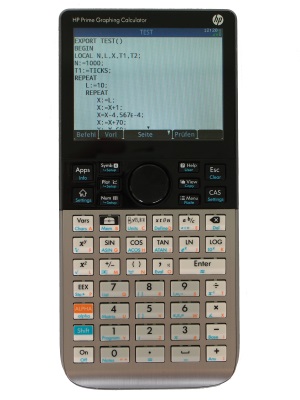
| Serial number | 4CY345000D |
| Accessories | Hardcover, CD-ROM with connectivity software and manuals, USB cable and power adapter |
| Condition | Mint out of the plastic cover box |
| Repairs, Comments | |
| Acquired | 14.11.2014 |
| Type, Precision, Input mode | Scientific, 12 BCD digits, exponent ±499, Algebraic and Reverse Polish Notation |
| Programmable | Yes. Programs can be entered using the
"Program" menu (Shift-1). The programming language is Pascal oriented. |
| Performance Index | 12454, see further down for the test program |
| Memory | 32 MByte DDR, 256 MByte Flash |
| Display | 320 x 240 pixel color graphics TFT display, touch-sensitive |
| Special features | USB-port, color and touch-sensitive display,
400 MHz ARM9 processort |
| Original Pricing, Production | 139 Euro in 11/2014 |
| Batteries | Built-in, recharges over USB-cable when connected to a PC or power supply. |
| Dimensions | Length 18.2cm, Width 8.5cm, Height 1.4cm |
| Links | HP-Prime
Homepage (German) HP Prime Graphing Calculator User Guide (PDF, English, 555 pages, Edition 1, May 2013) HP Prime Graph-Taschenrechner Kurzanleitung (PDF, Deutsch, 78 pages, Ausgabe 1, 1.5.2013) HP Prime Tutorial Series 1, Series 2, Series 3, Series 4 (PDF) |
| Comment | Well, not bad! Without any doubt there's a
gazillion of cool programs and tools and educational examples stored in
256 MB of flash memory. The quarter-VGA display comes with colors,
something that became only recently state of the art in the pocket
calculator realm. What really surprised me was the touch-sensitivity of
the display! The keys offer a nice feedback very close to the old and famous HP calculators. But the printing on the keys is ugly, looks cheap, and is hard to read. Especially the text printed in the signal orange color. |
The CD-ROM comes with two PC programs:
|
|
| Test program | Here's
the test program to determines the Prime's performance index (curtesy
Tom Lake): EXPORT TEST() BEGIN LOCAL N,L,X,T1,T2; N:=1000; T1:=TICKS; REPEAT L:=10; REPEAT X:=L; X:=X+1; X=X-4.567E-4; X:=X+70; X:=X-69; X:=X*7; X:=X/11; L:=L-1; UNTIL L==0; X:=LN(X); X:=SIN(X); X:=√X; X:=√X; N:=N-1; UNTIL N==0; T2:=TICKS; PRINT(T1+" "+T2+" "+(T2-T1)); END; Note that "TICKS" returns the current CPU time in milli-seconds. The execution time of this program is reproducably around 2.73 seconds. |
| Back To Contents |